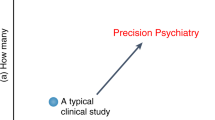Abstract
Naturalistic observational techniques were employed over a four-week period to assess the behavior of clinically improved (n=7) and unimproved (n=12) hospitalized patients suffering from acute psychiatric disorders. The population was selected from four clinical diagnostic groups. Patients were sampled on an individual basis. Categories of recorded behaviors included social behavior as well as spatial proximity measures between individuals. Social behavior was further divided into components of sending and receiving. Results showed that patients who clinically improved had significantly different behavioral profiles and greater degrees of behavioral change for the following categories: send affiliation, receive affiliation, send assertion, and receive assertion. Improved patients also maintained closer distance to other individuals during the latter stages of hospitalization. In most cases, week 2 of hospitalization marked the point at which behavioral divergence between improved and unimproved patients occurred. Clinical and theoretical implications of observational procedures are discussed.
Similar content being viewed by others
References
Alden, L. Treatment environment and patient improvement.Journal of Nervous and Mental Disease, 1978,166, 327–334.
Burdock, E. I., Hakerem, G., Hardesty, A. S., & Zubin, J. A. Ward behavior rating scale for mental hospital patients.Journal of Clinical Psychology, 1960,16, 246–247.
Esser, A. H. Interactional hierarchy and power structure on a psychiatric ward: Ethological studies of dominance behavior in a total institution. In S. J. Hutt & C. Hutt (Eds.),Behavior studies in psychiatry. Oxford, U.K.: Pergamon, 1970.
Fairbanks, L. A., McGuire, M. T., Cole, S. R., Sbordone, R., Silvers, F. M., Richards, M., & Akers, J. The ethological study of four psychiatric wards: patient, staff and system behaviors.Journal of Psychiatric Research, 1977,13, 193–209.
Frame, R. E. Interobserver agreement as a function of the number of behaviors recorded simultaneously.Psychological Record, 1979,29, 287–296.
Grant, E. C. An ethological description of some schizophrenic patterns of behavior. InProceedings of the Leeds Symposium on Behavioral Disorders. Essex, U.K.: May and Baker, 1965.
Harmatz, M. G., Mendelsohn, R., & Glassman, M. L. Behavioral observation in the study of schizophrenia.Proceedings of the 81st Annual Convention of the American Psychological Association, 1973,8, 451–452.
Honigfeld, G. Nurses' observation scale for in-patient evaluation (NOISE-30). Springfield, Ill.: Charles C. Thomas, 1970.
Hunter, M., Schooler, C., & Spohn, H. E. The measurement of characteristics of patterns of ward behavior in chronic schizophrenics.Journal of Consulting Psychology, 1962,1, 69–73.
Ittelson, W. H., Rivlin, L. G., & Proshansky, H. M. The use of technical maps in environmental psychology. In H. M. Proshansky, W. H. Ittelson, & L. G. Rivlin (Eds.),Environmental Psychology: Man and his physical setting. New York: Holt, Rinehart and Winston, 1970.
Jones, I. H., & Pansa, M. Some nonverbal aspects of depression and schizophrenia occurring during the interview.Journal of Nervous and Mental Disease, 1979,167, 402–409.
Marder, S. R., Van Kammer, D. P., Docherty, J. P., Rayner, J., & Bunney, W. E. Predicting drug-free improvement in schizophrenic psychosis.Archives of General Psychiatry, 1979,36, 1080–1085.
McGuire, M. T., Fairbanks, L. A., Cole, S. R., Sbordone, R., Silvers, F. M., Richards, M., & Akers, J. The ethological study of four psychiatric wards: Behavior changes associated with new staff and new patients.Journal of Psychiatric Research, 1977,13, 211–224.
McGuire, M. T. A descriptive, research-justified data base for clinical psychiatry: would it change things?Perspectives in Biology and Medicine, 1978,21, 240–257.
McGuire, M. T., & Polsky, R. H. Behavioral changes in hospitalized acute schizophrenics: an ethological perspective.Journal of Nervous and Mental Disease, 1979,167, 651–657.
Overall, J. and Gorham, D. The brief psychiatric rating scale.Psychological Reports, 1962,10, 799–812.
Polsky, R. H., & McGuire, M. T. An ethological analysis of manic-depressive disorder.Journal of Nervous and Mental Disease, 1979,167, 56–65.
Polsky, R. H., & Chance, M. R. A. An ethological perspective on social behavior in long stay hospitalized psychiatric patients.Journal of Nervous and Mental Disease, 1979,167, 658–668.
Salzinger, K.Schizophrenia: behavioral aspects. New York: Wiley, 1973.
Winer, B.Statistical principles in experimental design, New York: Wiley, 1970.
Author information
Authors and Affiliations
Rights and permissions
About this article
Cite this article
Polsky, R.H., McGuire, M.T. Observational assessment of behavioral changes accompanying clinical improvement in hospitalized psychiatric patients. Journal of Behavioral Assessment 2, 207–223 (1980). https://doi.org/10.1007/BF01321439
Accepted:
Issue Date:
DOI: https://doi.org/10.1007/BF01321439




